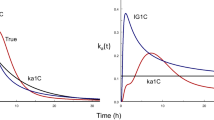Abstract
Purpose. Two methods to confirm attainment of steady-state conditions in multiple-dose bioequivalence studies are described and evaluated: (1) the Cmin method and (2) the Area Below the Cmin plasma-concentration-versus-time-curve method (ABCM method).
Methods. Cmin Method—After repetitive drug administration to presumed steady-state, successive trough, or Cmin, values are evaluated to determine if they are equal. ABCM Method—The ABCM of successive doses from dose two to presumed steady-state [ABCM(ss)] are divided by the ABCM for the first dose, ABCM(t), to give ABCM(ss)/ ABCM(t)=R, which describes the increase in ABCM(n) with successive doses. The quantity, R, is then divided by an accumulation ratio to render the value independent of intra-subject clearance differences. Monte Carlo simulations were done to test the effects of data error and slow-clearing subpopulations on the method's performance. Data from multiple-dose bioequivalence studies were evaluated using confidence intervals for both methods to determine how well each predicted steady-state for immediate-release and controlled-release drug products.
Results/Conclusions. The Cmin method more accurately predicted the attainment of steady-state conditions for immediate-release formulations compared to the ABCM method. Conversely, the ABCM procedure more accurately predicted the attainment of steady-state conditions for controlled-release formulations compared to the Cmin method. The simulation results were further supported by the experimental data.
Similar content being viewed by others
REFERENCES
Guidelines for Oral Extended (Controlled) Release Dosage Forms In Vivo Bioequivalence and In Vitro Dissolution Testing, Guidance Prepared by the Division of Bioequivalence, U.S. Food and Drug Administration (1993), Rockville Maryland.
J. P. Skelly, W. H. Barr, Benet, J. T. Doluisio, A. H. Goldburg, G. Levy, D. T. Lowenthal, J. R. Robinson, V. P. Shah, R. J. Temple, and A. V. Yacobi. Report of the workshop on controlled-release dosage forms:issues and controversies. Pharm. Res. 4:75–77 (1987).
W. A. Ritshel. Bioavailability/Bioequivalence of modified release drug delivery systems: Which pharmacokinetic parameters to determine, single or multiple dose studies, pretests, conditions and other aspects. Meth. Find. Clin. Pharmacol. 14:469–482 (1992).
W. A. Colburn, Estimating the accumulation of drugs. J. Pharm. Sci. 72:833–834 (1983).
M. Gibaldi and D. Perrier. Multiple Dosing, in Pharmacokinetics, Swarbrick J. Ed.; Marcel Dekker: New York, 2nd edition, Chapter 3, pgs 132–144, 1982.
A. A. El-Tahtawy, A. J. Jackson, and T. M. Ludden. Comparison of single and multiple dose pharmacokinetics using clinical bioequivalence data and Monte Carlo simulations. Pharm. Res. 11:1330–1336 (1994).
B. J. Kline, V. A. Turner, and W. H. Barr. Determination of quinidine and dihydroquinidine by high performance liquid chromatography. Anal. Chem. 51:449–451 (1979).
Author information
Authors and Affiliations
Rights and permissions
About this article
Cite this article
Jackson, A.J. Evaluation of a Cmin and a Normalized Cmin Method for the Confirmation of Steady-State in Bioequivalence Studies. Pharm Res 15, 1077–1084 (1998). https://doi.org/10.1023/A:1011990413450
Issue Date:
DOI: https://doi.org/10.1023/A:1011990413450




